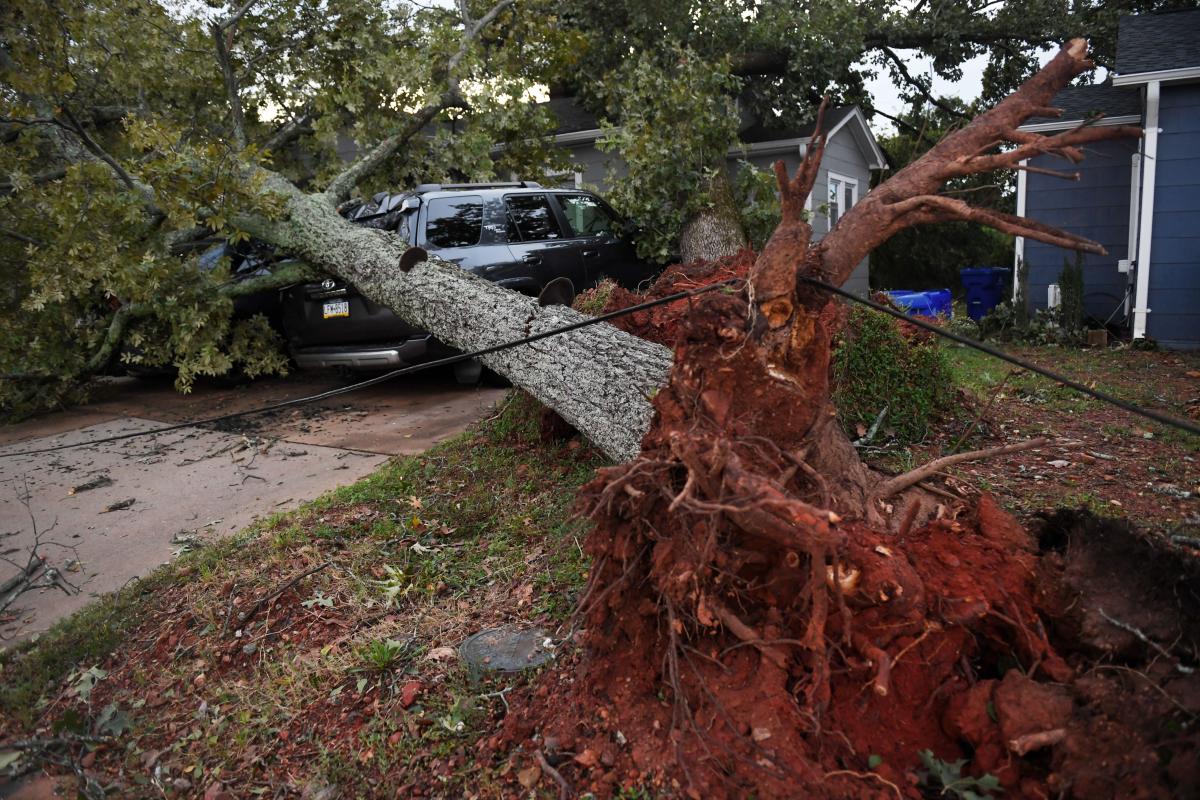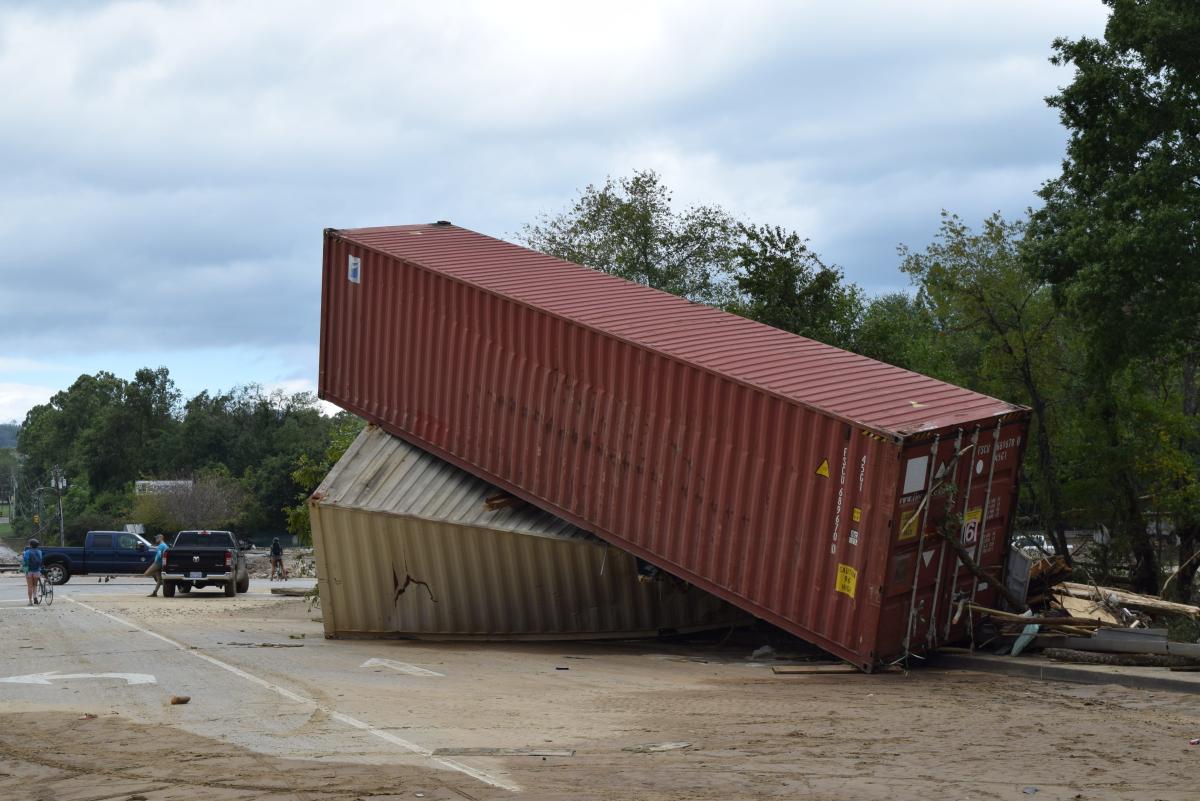(This story was updated because an earlier version included an inaccuracy. A video was also added. )
Helene’s swath of destruction has caused historic rainfall, flooding, power outages and 140-mile-an-hour winds across the Southeast. But it was North Carolina that bore the brunt of it Saturday with vast swaths of cities like Asheville underwater, residents trapped in their homes with no lights or food and few functioning roads for rescue workers to help them.
Helene, Gov. Roy Cooper declared, had become “one of the worst storms in modern history for parts of North Carolina.”
Zeb Smathers, the mayor of Canton, N.C., took to Facebook during a quick break from responding to what he described as “an unimaginable and horrific disaster.”
“I have limited time to post, but this is the first message I’ve been able to share following the apocalyptic flooding that hit us” and breakdowns in cellular communications that followed, Smathers wrote. “My heart is broken, not only for our town but for the entire region.”
More than 400 roads remained closed in the Tar Heel State, including “all roads in Western NC,” the North Carolina Department of Transportation said in a post on X. “Remember: As crews work to clear and inspect roads and bridges, please give them room.”
Crews needed more than just room to operate. Well over 2 feet of rain had fallen across the state’s mountainous region in recent days thanks to a rare confluence of weather patterns over the eastern U.S. before Helene arrived in Florida on Thursday night.
Tiny Busick in Yancey County along the western border with Tennessee, recorded 29.58 inches in just 48 hours. In Asheville, record high levels were set on the French Broad River and the Swannanoa River near the Biltmore estate. The historic Biltmore Village nearby was nearly submerged after Helene tore through the area, according to aerial footage,.
At least 5,000 emergency calls to 911 were fielded since Sept. 26. And with more than 200 North Carolinians requiring rescue from following Helene’s torrential rains, local, state and federal officials mobilized to help.
North Carolina, like Georgia and Alabama, activated hundreds of its own National Guard, and the governors of Maryland, and at least 17 other states sent Guard units of their own. Three federal teams were also deployed, and supplies were being airlifted in Saturday as and search and rescue operations continued throughout the state, Cooper said.
Helene made landfall at about 11:10 p.m. ET Thursday near Perry, Florida, becoming the first known Category 4 storm to hit Florida’s Big Bend region since records began in 1851. The storm continued its push across western Kentucky on Saturday, and was expected to slowly move southeast, then east along the Kentucky-Tennessee border through the weekend, the National Hurricane Center said.
Biden briefed on ‘tragic loss of life,’ devastation
On Saturday, President Joe Biden approved emergency disaster relief aid for Tennessee. On Saturday evening, Biden was briefed on the impacts of Helene on multiple Southeastern states, including Florida, Georgia, North Carolina, South Carolina, Alabama, and Tennessee, by Homeland Security Advisor Liz Sherwood-Randall and Deanne Criswell, the administrator of the Federal Emergency Management Agency (FEMA).
“Criswell described the tragic loss of life across the region and the devastation in the Big Bend communities of Florida that she visited today,” a statement from the White House said. Criswell will travel to Georgia on Sunday and North Carolina on Monday, it said, as part of the administration’s effort to speed support to survivors and deploy more search and rescue teams to “accelerate recovery efforts” in North Carolina.
“The President will be briefed on an ongoing basis through the weekend,” the White House said.
Downed trees, power lines across region
High winds gusting up to hurricane strength brought down trees, power lines and cell towers across the region. Dozens of deaths have been attributed to Helene’s onslaught, according to authorities and media reports across the Southeast. A tally of the deaths approached 50 on Saturday morning, and officials said they expected the death toll to keep rising as they continued to go door-to-door in the aftermath of the storm.
According to the USA TODAY power outage map, there were 635,887 total outages reported in North Carolina on Saturday afternoon. In response, crews from across the United States were on scene to help with immediate restoration and repair efforts, North Carolina’s Department of Public Safety said. On Friday night, 16 shelters in the state housed about 1,100 residents.With cellphone service spotty in western areas of the state, telecom companies activated “disaster roaming,” “allowing any phone on any cellular network to access any available network to connect to,” according to the state’s public safety department.
Statewide, at least 29 North Carolina counties and 52 towns and cities issued state of emergency announcements, in addition to the statewide emergency declaration Cooper issued on Wednesday in advance of the storm.
“This is a historic and catastrophic storm for Western North Carolina and I’m grateful to first responders working right now to save lives and evacuate residents,” Cooper said.
Why is Helene so destructive?
Forecasters began warning last Tuesday that a confluence of weather patterns was coming together that would likely soak the region. A front overhead was going to interact with a plume of moisture being pulled in ahead of Helene.
The rain “started well ahead of the storm, training up from the Gulf into our area, and circulation around the storm pushed moisture up from the extremely warm Gulf waters,” said David Easterling, a rain expert with NOAA’s National Climate Assessment Technical Support Unit.
Interactions like this, with a band of moisture ahead of a tropical storm or hurricane, are called predecessor events and they’ve been documented in the past to cause heavy rains ahead of the arrival of tropical storms and hurricanes. Jet stream winds blowing aloft at more than 115 mph provided lift that further enhanced moisture in the developing storms.
By Wednesday, the National Weather Service warned that rain in parts of the region could fall at rates up to 3 inches an hour.
Satellite images showed how the cyclone and the upper level low to the northwest more or less merged on Wednesday, said David Roth, a meteorologist with the Weather Prediction Center.
Along the Blue Ridge Mountains in North Carolina on Wednesday and Thursday, almost 10 inches of rain fell in Asheville and 8 inches in Tryon, according to preliminary weather service data. Another six inches fell over the two days in Bristol-Johnson, Tennessee and more than 4 inches in Knoxville.
Helene’s massive circulation moved into the mix with more rain, and then transitioned into a post tropical cyclone.
Rain flowing into rivers in the mountainous areas quickly turned into cataclysmic flooding, setting an all-time record high on the Pigeon River at Newport, Tennessee. At least three of the flood level records broken Friday were set more than a century ago, when the lingering remnants of one tropical system in July 1916 were followed by another, producing heavy rain.
Floodwater, which weighs 1,700 pounds per cubic yard, washed away roads and cars and stranded residents in mountain communities. At Unicoi County Hospital in Erwin, Tennessee, floodwaters stranded 54 people on the roof.
By Friday evening, record-breaking rainfall totals were reported in some Southeast locations, with more than a foot of rain across swaths of Georgia and South Carolina. Tennessee, Virginia and West Virginia saw widespread amounts ranging from 4 to 7 inches.
Eyepopping rainfall totals were measured elsewhere in the North Carolina mountains besides Busick. Mount Mitchell, the highest peak east of the Mississippi River and a landmark along the Blue Ridge Parkway, got hit with more than 2 feet.
That rain in the high North Carolina mountains then created the raging torrents across the Southeast that forced people from their homes in the dead of night Friday along the Nolichucky River in eastern Tennessee.
This article originally appeared on USA TODAY: Helene swamps North Carolina, with historic flooding, outages














